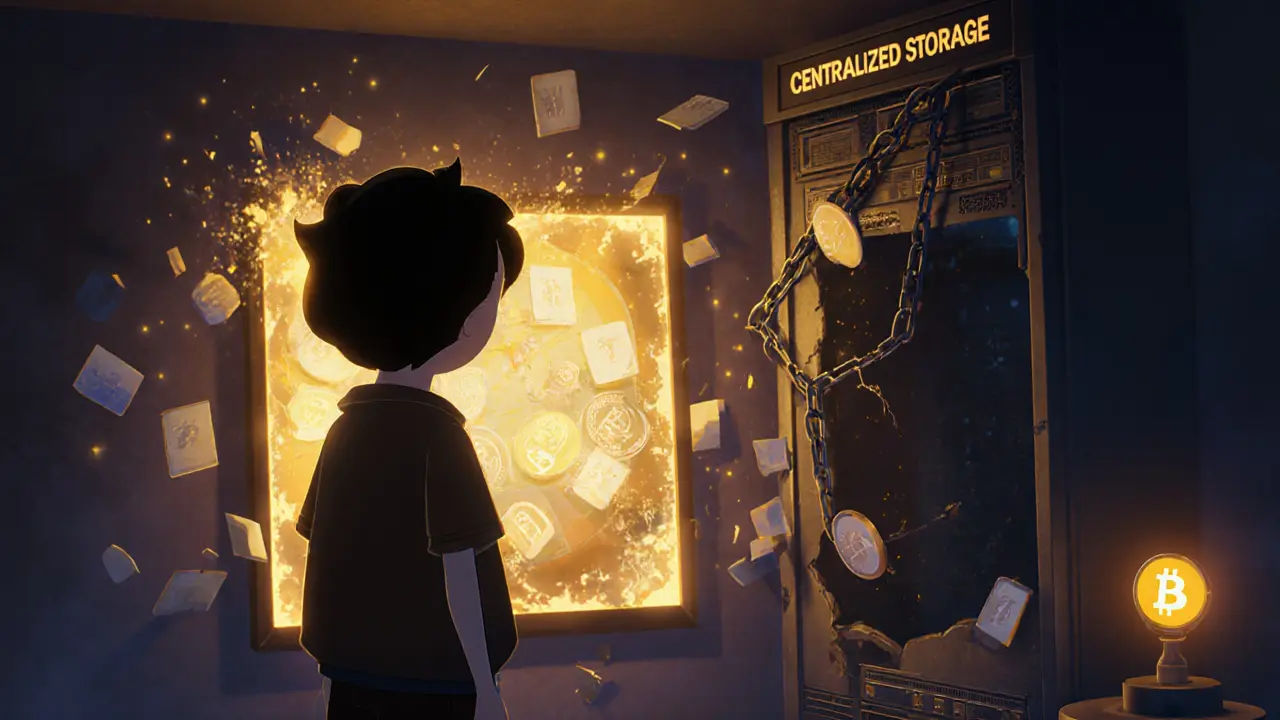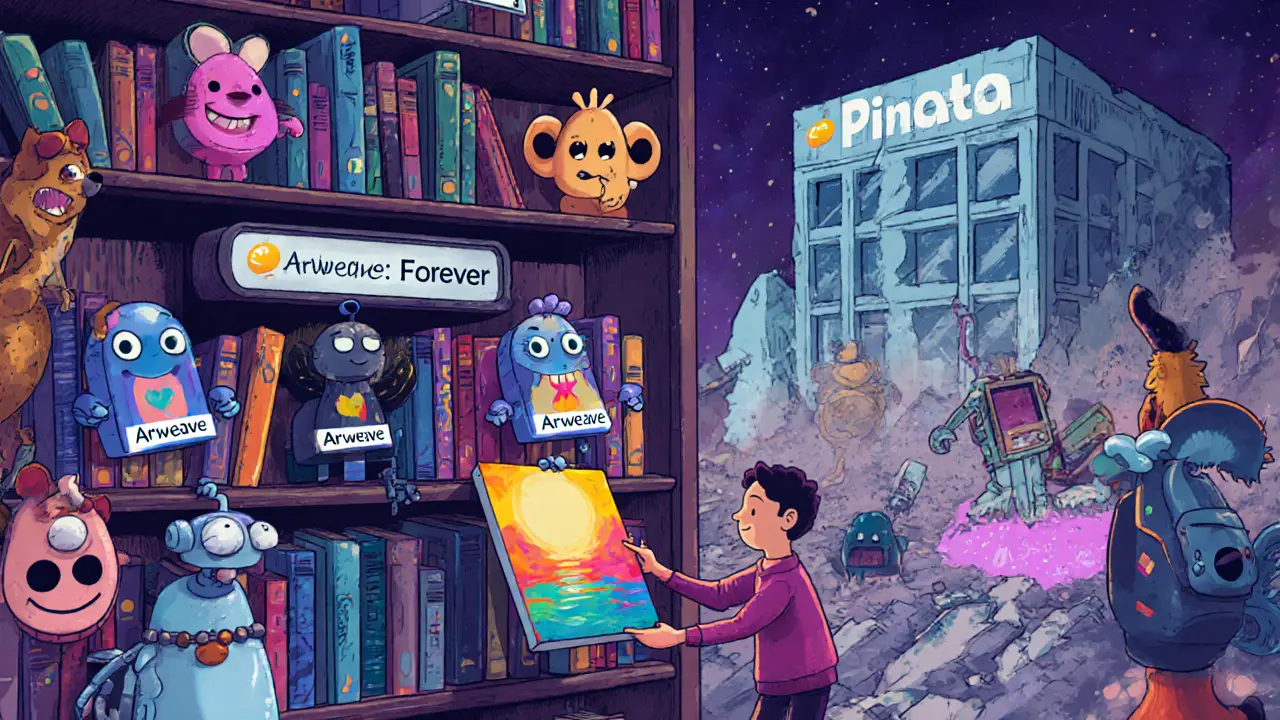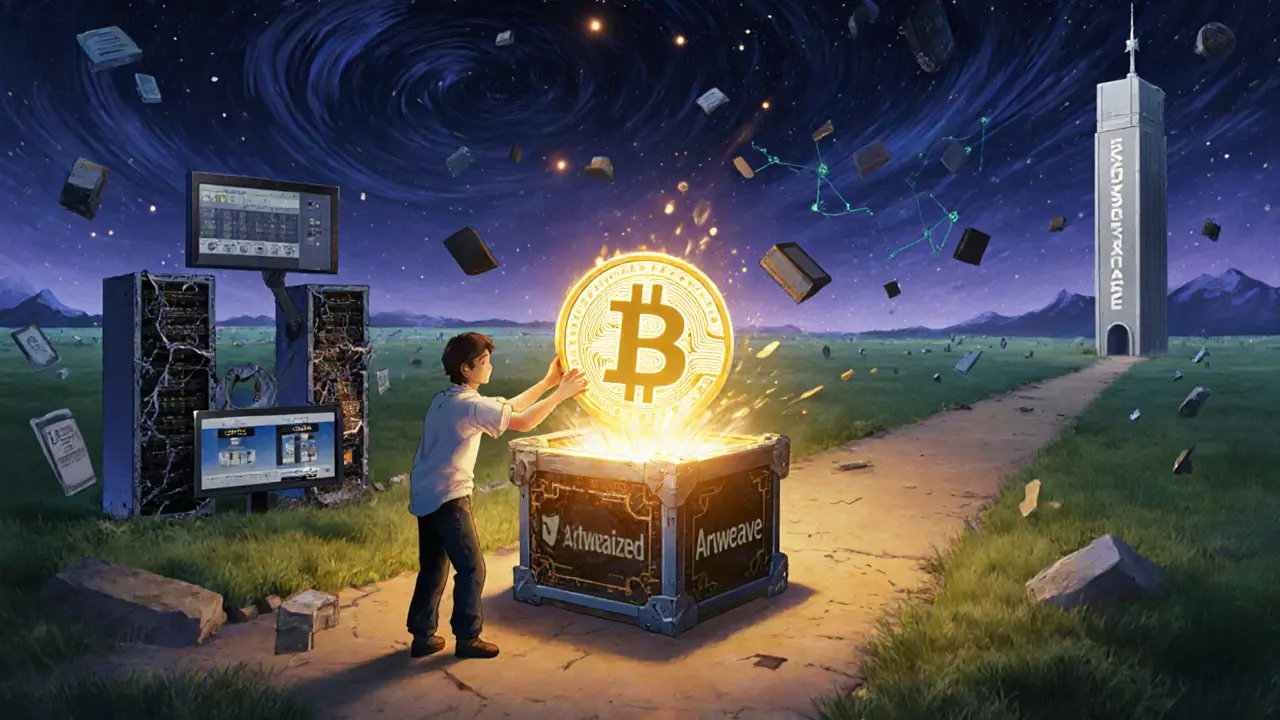 Nov, 12 2025
Nov, 12 2025
NFT Storage Checker
Imagine buying an NFT of a digital artwork. You pay the money. You get the token. You feel proud. Then, one day, you check your collection-and the image is gone. Just a blank screen. A broken link. That’s not a glitch. That’s what happens when your NFT is stored on a centralized server. And it’s happening more often than you think.
Why NFT Storage Matters More Than You Think
NFTs aren’t the art itself. They’re a digital certificate of ownership. The actual image, video, or audio? That’s stored somewhere else. Most people assume because it’s on the blockchain, it’s safe forever. It’s not. The blockchain only records the link to the file-not the file itself.
That link? It could point to a server owned by a startup that went bankrupt. Or a cloud provider that shut down its NFT service. Or a website that got hacked. If that server goes down, your NFT becomes a fancy digital placeholder. No art. No value. Just a token pointing to nothing.
This isn’t hypothetical. In 2022, over 10% of NFTs on major marketplaces had broken links. By 2024, that number was still above 7%. And it’s not because the blockchain failed. It’s because the storage underneath it didn’t hold up.
What Is IPFS? The Decentralized Alternative
IPFS-InterPlanetary File System-is a peer-to-peer network that stores files by their content, not their location. Think of it like a library where books are labeled by their exact text, not by shelf number. If you want a book, you ask for its unique title (a hash), and any library with a copy gives it to you.
Each file gets a Content Identifier (CID). That CID is what your NFT stores. When someone opens your NFT, their wallet asks the IPFS network: "Who has this CID?" And if even one node has it, the file loads. No single company controls it. No central server to crash.
That’s the promise: permanence. Censorship resistance. True ownership. If you own the NFT, you own the link to the file. And as long as someone out there is keeping that file alive, your art stays visible.
IPFS is open-source. Anyone can run a node. Developers can build tools on top of it. And it’s already being used by OpenSea, SuperRare, and other major platforms. But here’s the catch: most of them don’t run their own nodes.
The Big Lie: "We Use IPFS"
Companies like Pinata, nft.storage, and Filebase market themselves as "decentralized storage" for NFTs. They’re not. They’re centralized services that use IPFS as a backend.
Here’s how it works: You upload your art to Pinata. They store it on their servers. They pin it to IPFS nodes they control. You get a CID. Everything looks fine. But if Pinata shuts down tomorrow? Your file might vanish from the IPFS network because no one else is pinning it.
It’s like saying you own a house because you rent it from a landlord who promises to never sell it. You have a key. But if they walk away, you lose access.
True decentralization means the data lives on hundreds of independent computers-not just a few owned by one company. If you want real permanence, you need to pin your own files, or use a network where others are incentivized to keep them alive.

Centralized Storage: Easy, But Risky
Centralized storage is simple. Upload your file to Amazon S3, Google Cloud, or a custom server. Link it to your NFT. Done. You get a clean dashboard. Customer support. SLAs. Predictable pricing.
For small creators, it’s tempting. No technical setup. No learning curve. Just drag and drop.
But here’s the reality: centralized storage has no built-in backup. No redundancy. No guarantees. If the company goes under-like the NFT platform that shut down in 2023 and erased 200,000 NFTs-your art disappears. If they change their policy? Your file gets removed. If they get hacked? Your data is exposed.
And there’s no way to prove the file hasn’t been altered. A centralized server can swap your original artwork for a lower-res version. No one knows. No audit trail. Your NFT still points to the same link-but the content is different.
That’s not ownership. That’s a lease.
IPFS Isn’t Perfect Either
Don’t get me wrong-IPFS isn’t magic. It’s a tool. And like any tool, it needs maintenance.
Files on IPFS only stay alive if someone is actively "pinning" them. That means keeping a copy on a node that’s always online. If no one pins your file, it fades away after a few months.
Most NFT projects don’t pin their own data. They rely on services like Pinata. That’s fine-until Pinata stops.
And IPFS can be slow. If you’re in New Zealand and the only node with your file is in Tokyo, it takes longer to load. No global CDN. No guarantees on speed.
Plus, it’s not user-friendly. You need to use command-line tools or third-party apps. Most collectors don’t know what a CID is. If your NFT’s image doesn’t load because of a networking issue, your buyer blames you-not the storage system.

What’s the Real Solution?
There’s a third option: on-chain storage. Store the art directly on the blockchain. No links. No servers. Just the data embedded in the token.
But it’s expensive. Storing a 1MB image on Ethereum costs over $1,000. Not practical for most artists.
That’s why newer protocols are emerging. Filecoin pays people to store data long-term using crypto incentives. Arweave lets you pay once-for forever. You buy a permanent storage slot, and the protocol uses endowment economics to keep your file alive for centuries.
Arweave’s model is simple: pay $50 today, and your NFT’s art stays up for 200 years. No company to shut down. No pinning needed. No middleman.
Some NFT projects are already switching. The Bored Ape Yacht Club is testing Arweave for new drops. Others are using Filecoin-backed storage with economic guarantees.
What Should You Do?
Here’s the real answer:
- If you’re a collector: Check where the NFT’s metadata is stored. Look at the CID. Use a tool like ipfs.io to see if the file loads. If it doesn’t, the NFT is broken.
- If you’re a creator: Don’t use centralized servers. Don’t rely on Pinata alone. Use Arweave or Filecoin. Pay once. Store forever.
- If you’re building a platform: Offer Arweave or Filecoin as the default. Make it easy. Don’t let creators accidentally choose centralized storage.
The future of NFTs isn’t about better art. It’s about better storage. If we keep using centralized servers, we’re building castles on sand. The blockchain gives us the power to create permanent digital ownership. But only if we actually use permanent storage.
IPFS is a step. But without active pinning or economic incentives, it’s not enough. The real winners will be the projects that choose true permanence-not convenience.
Is IPFS Better Than Centralized Storage?
Yes-if it’s used right. But most NFTs using "IPFS" aren’t actually using IPFS. They’re using a centralized service pretending to be decentralized.
True decentralization means no single point of control. No company that can turn off your art. No server that can crash. That’s what IPFS promises. And that’s what centralized storage can’t deliver.
The choice isn’t between two storage types. It’s between ownership and dependency.
Can I recover my NFT art if the company that hosted it shuts down?
Only if the file was stored on a decentralized network like IPFS and someone else pinned it, or on a permanent storage protocol like Arweave. If it was on a centralized server like Amazon S3 or a startup’s private server, the art is likely gone forever. Most NFTs hosted on centralized platforms have no backup, and when the company closes, the files are deleted.
Why do most NFT marketplaces say they use IPFS if it’s not reliable?
Because IPFS sounds decentralized, and it’s a marketing advantage. Most marketplaces use centralized services like Pinata or nft.storage to host the files. These services handle the pinning for them, so they can claim "IPFS storage" without running their own nodes. It’s a technical loophole that lets them look decentralized while still depending on a single company.
Is Arweave better than IPFS for NFT storage?
For long-term permanence, yes. Arweave charges a one-time fee to store data forever using an endowment model-meaning the cost is pooled and used to pay miners to keep the data alive indefinitely. IPFS has no economic incentive for long-term storage. Files disappear unless someone actively pins them. Arweave removes the need for pinning, making it more reliable for NFTs meant to last decades.
Can I store NFT art directly on the blockchain?
Yes, but it’s expensive. Storing even a small image on Ethereum can cost hundreds of dollars in gas fees. That’s why most NFTs don’t do it. Some blockchains like Solana and Polygon allow cheaper on-chain storage, but they still aren’t practical for large files like videos or high-res art. On-chain storage is the gold standard for permanence, but it’s only viable for small, simple assets.
How do I check if my NFT’s storage is decentralized?
Look up your NFT’s metadata URL. If it starts with "ipfs://", copy the CID (the long string after ipfs://) and paste it into https://ipfs.io/ipfs/[CID]. If the image loads, it’s on IPFS. But to know if it’s truly decentralized, check if it’s stored on Arweave (starts with "arweave://") or if the provider is a known centralized service like Pinata. True decentralization means no company name in the URL.